It is impossible for Godhra to have been the result of petty quarrels at the Godhra railway station. Slogans shouted from a moving train or a railway platform or even true or false rumours of attempted abduction of a girl cannot make 2,000 Muslims assemble in five minutes already having managed to procure petrol bombs and acid bombs, that too at 8 am. 140 litre of petrol was bought in cans a day before the massacre. Initially, many said the same about Godhra being planned.
For the train to have been attacked, the attackers (Muslims) had to surround in on at least two sides. If it was on the spur of the moment, it would have been very difficult for the Muslims to surround the train on both sides. How could at least 500 Muslims reach the other side of the train? If that was the case, then the karsevaks would have ran out of the train and saved their lives, by running from the second side before Muslims reached there.
Kuldip Nayar, known for his anti-RSS, anti-BJP and pro-Muslim views, wrote in an article published on 3 April 2002: “I have no doubt that the (Godhra) attack was a well-planned one. Otherwise, it is not possible for a mob of 500 carrying petrol and kerosene to assemble in three minutes in an area that can only be reached by running through prickly bushes.”
On 3 March 2002, The Indian Express wrote: “…the burning of the train (Godhra) was a pre-meditated act by a well-armed and primed up Muslim mob. Because even if there was a provocation, a mob of this size, with so much incendiary power in its hands and so much hatred in its head does not collect in a place like Godhra in a few minutes. Somebody was expecting the arrival of this train and had laid an ambush.”
Later India Today reported in its 22 July 2002 issue: “The theory that there was a conspiracy behind the massacre gains credence in the light of the accounts of the five firemen who fought the blaze. They have told investigators that Haji Bilal, Godhra municipality councillor and prime accused in the case, obstructed their fire tender and tried to prevent them from putting out the fire in the coach. Vijay Sharma, one of the firemen, says Bilal had called the fire brigade on the night of February 26 and asked for the names of the firemen who would be on duty the next morning. Coincidentally, that same evening a water tanker attached to the fire station and a fire tender both developed serious engine snags. It would, of course, be naive to think that conspirators depend on coincidences to accomplish their deadly missions.”
Haji Bilal was found guilty by the trial court, and given death penalty. He was found guilty of obstructing the fire brigade which rushed to douze the fire. He trying to sabotage the fire brigade equipment and call to know the names of the firemen who would be on duty the next morning on 26 February night is conclusive evidence that the massacre was planned well in advance, and could not be the result of any ‘provocation’. Even if, for argument’s sake, there was any unsuccessful attempt to kidnap a girl on 27 February morning, it doesn’t change the fact that the attack was planned.
There was a judicial confession by an accused in February 2003 that Godhra was planned, 140 litre of petrol been purchased in 7 cans of 20 litre capacity the previous night, and that he had himself taken part in the massacre. A judicial confession is a conclusive proof. Though he later retracted his confession in August 2003, his judicial confession before a judge in court in February 2003 removes all possible doubts anyone can ever have about Godhra.
The Times of India reported on 7 February 2003:
“VADODARA: Zabir Bin Yamin Behra has given the Godhra carnage case a new twist and stunned everyone by accusing Maulana Hussain Umarji of hatching the conspiracy. He has also confessed his own involvement in the case. Behra has a long criminal history.
He has committed both petty and serious crimes and has mostly operated in the station area of Godhra town since a young age. He belongs to the same rung of people as Abdul Razzak Mohammed Kurkur and others. Both the Godhra railway police station and the town police station have offences registered against him…
…Besides having a hand in the burning of the coach, Behra confessed to removing ornaments and valuables of passengers, when the mob attacked the train.”
In this report, The Times of India did not mention that this confession was to court, i.e. a judicial confession, which it mentioned in another report, which can be read by opening this link: https://timesofindia.indiatimes.com/city/ahmedabad/behera-shifted-to-prison-in-nadiad/articleshow/39605079.cms
He also confessed to looting ornaments and valuables of the passengers before burning the train, thereby proving the testimony of 16-year-old Gayatri Panchal who survived the attack and said exactly the same, as correct.
PTI reported on 6 February 2003, as reported in The Tribune on 7 February 2003:
“The maulvi’s arrest by the police from the Signal Falia area in the wee hours followed disclosures by one of the accused, Zabir Bin Yamin Behra, who claimed that Umarji was the brain behind the train carnage. The 56-year-old religious leader was arrested in a joint operation by the railway and city police. Behra, during his confession before city Chief Judicial Magistrate yesterday, alleged that the maulvi had “masterminded” the carnage and instigated youths for “planned attack” on February 26, a day before kar sevaks were to return from Ayodhya after participating in “shila poojan”.”
https://www.tribuneindia.com/2003/20030207/main4.htm
Rediff.com reported on 19 February 2003:
“Gujarat to slap POTA against Godhra accused
February 19, 2003 20:18 IST
The Gujarat government has decided to slap the Prevention of Terrorism Act against all the accused involved in the Sabarmati Express carnage, state Home Minister Amit Shah said on Wednesday [19 February 2003].
“The decision was taken on Tuesday [18 Feb] after one of the accused, Zabir Bin Yamiun Behra, confessed in the court that the conspiracy was hatched three-four days before the carnage and that Maulvi Husain Umarji was the main conspirator,” Shah said.
…Meanwhile the Special Investigation Team officials, in the application moved to additional sessions judge of Godhra K C Kela, stated that the conspiracy to torch the train was hatched in Aman Guest House, owned by another prime accused Razzak Kurkur, in the town.
The application, according to sources, also mentions that accused, Salim Panwala, who is still absconding, was supposed to keep a check on timings of Sabarmati Express arriving at Godhra station, while it was decided that petrol would be transported through loading rickshaws.
The petrol was brought by accused Shaukat Lalu, Hussain Lalu and Zabir Bin Yameen and Imran, stated the application, according to reports from Godhra.
The SIT also stated that as per the conspiracy vendors at the station would enter into a verbal altercation with the karsevaks arriving from Ayodhya.
…Zabir Yamin Behra, an accused in the case, had confessed before a magistrate that Maulvi Umarji had agreed to give Rs 1500 each per month to the members of the core team for torching the coach…”
http://www.rediff.com/news/2003/feb/19guj.htm
After this confession, the report in India Today in the 24 February 2003 issue was:
“…Umarji, a prominent leader of the Deobandi-Tableegh Jamaat movement in the Godhra region, has been charged with being part of the conspiracy as well as obstructing investigations by protecting the accused. The mob that burnt down compartment S-6 is believed to have been drawn from the local Ghanchi community, zealous followers of the Tableegh Jamaat, a puritanical sect that set up shop in Godhra in the mid-1970s….
…What cornered Umarji was the confessional statement of Jabir Binyamin Behera, the principal accused in the Godhra case. Arrested on January 22, Behera gave the court of the chief metropolitan magistrate, Godhra, crucial details.
Besides implicating Umarji, Behera also referred to the role of Razak Kurkur, another accused in the case. Kurkur’s Aman Guest House, located near the Godhra railway station, was virtually the base of terror. At 9.30 p.m. on February 26, 2002, the evening before the murders, six people held a war council at Aman Guest House. They included Behera, Kurkur, Salim Paanwala, alias Badam, and Salim Zarda. They decided to set the Sabarmati Express on fire.
The strategy was simple: at the slightest provocation from the Ramsevaks, or even without one, begin a full-fledged assault. At 10.15 p.m., the conspirators bought seven 20-litre cans of fuel from Kalabhai petrol pump and stored them at Aman Guest House. [Our comment: This was also stated by the Nanavati Commission] …
…(Salim Panwala) told Behera that the train was running four and a half hours late. It would not arrive at the scheduled time of 3.30 a.m. The original plan of killing the Ramsevaks in pre-dawn darkness had to be dropped.
The plotters regrouped at 6 a.m. and finally attacked the train a little after 8 a.m. A mob of Ghanchi Muslims from the nearby Signal Fadia colony had already been primed. The 140 litres of petrol was transported to the railway station on a rickshaw. The initial idea was to fling the petrol into coach S-6 through the windows.
At about 7 ft, these proved too high. Behera and a few others then cut down the canvas cover of the rear vestibule of coach S-6. They clambered in, broke open the door and emptied the seven cans of petrol inside. It took a few burning rags to do the rest…”
This judicial confession should have been mentioned repeatedly by the media post February 2003 whenever reporting on Godhra. This was needed even more when the Banerjee Committee constituted by the then Union Railway Minister Lalu Yadav gave a report calling Godhra an ‘accident’ in January 2005 in its interim report, and in March 2006 in its final report, and when the Committee was declared illegal and its appointment was quashed by the Gujarat High Court in October 2006. Instead, this judicial confession was suppressed totally and unnecessary confusion was sought to be deliberately created on Godhra.
Such a horrific crime should not be committed even against animals. If 59 animals had been locked in a train, pushed back into the fire as they tried to come out and then roasted to death with bodies charred, it too would have been considered as a gruesome tragedy by all sensible people. But false charges were made on Godhra victims; the incident was condemned merely for token with the blame put on the roasted women and children and men, and the VHP. Vir Sanghvi said that the karsevaks had been dehumanized. They were actually treated even worse than animals.
And when the things were really a result of provocation, the ‘secularist’ media largely just ignored it. The big ‘provocation’, Godhra, was far more than a ‘provocation’ but the cause of the retaliation. The post-Godhra riots were reported ignoring Godhra completely. Only the Hindu retaliation of the first three days was decried. And even after so many years, whenever the post-Godhra riots are mentioned, Godhra is completely ignored and it is made to sound as if the BJP Government of the state indulged in ruthless, unprovoked killings of Muslims in alliance with the VHP and the Bajrang Dal.
The difference in attitude is revealed from the reactions. After Godhra, it was said by the ‘secular’ media: “The government must bring the culprits to justice. The crime deserves to be condemned. But it is inevitable and predictable because of VHP’s Ayodhya movement…VHP bashing…” and after Godhra, it was said: “Holocaust…pogrom…genocide…massacre… Modi must quit… international shame…are we like Rwanda…Hitler…”
Vir Sanghvi said, “If you report the truth, then you will inflame Hindu sentiments and this would be irresponsible. And so on.” That is to say, Vir Sanghvi admitted that the secularists utter ‘stark lies’, no matter what interest in mind. In reality, they inflamed Hindu sentiments by insulting the dead kar sewaks. Had they told the reality that ‘Muslims killed the 59 kar sewaks in a planned attack’ and then said ‘but its revenge should not be taken on other Muslims’, then perhaps the Hindu retaliation could have been prevented. This was the position taken by the RSS – blaming the attackers but calling for restraint.
On 27 February 2002, senior Congress leader and former Gujarat Chief Minister, the late Amarsinh Chaudhary (1941-2004) came on TV at night and while condemning the attack, also blamed karsevaks for provoking it by alleging that they refused to pay for tea at the station. (Again following Vir Sanghvi’s observation—they condemn the crime, but blame the victims.) This statement of Chaudhary had a devastating effect.
Pro-RSS weekly Organiser reported the incident in its issue dated 10 March 2002, which covered events in full till 27th February. While reporting on this issue, Organiser reported a news item titled “RSS condemns the killings and calls for restraint” and this report carried the statement of the then RSS Joint General Secretary, Madan Das Devi that ‘RSS urges Hindu society to exercise restraint after the Godhra attack’. RSS had asked the Hindu society to not retaliate after Godhra before the riots had started.
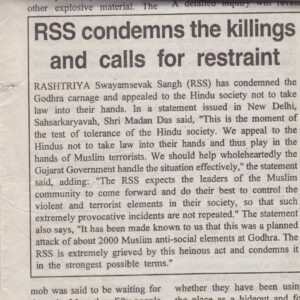
This is the scanned copy of the report of Organiser dated 10 March 2002. The scanned copy of the report of another appeal issued on 27 February by the then General Secretary of RSS, Mohan Bhagwat, as reported by Organiser on the same page of the same issue, is seen below.
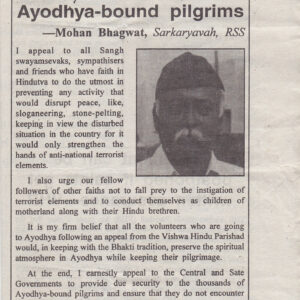
Mohan Bhagwat urged people to shun acts like even sloganeering, apart from stone pelting and anything that would violate peace.
India Today dated 11 March 2002, carrying events till 28th February 2002, reported on the last page of the cover story:
“The mood in the state is militant. A procession of 10,000 marched with the bodies of 11 people from Ramol village near Ahmedabad, who had died in the train. They were shouting slogans like: ‘Tumhari shahidi bekar nahi jayegi, Mandir bana kar hi rahenge’ (Your sacrifice will not go in vain, we will build the temple)… This incident drew mixed reactions from the Congress, the main opposition party in the state. While senior party leader Amarsinh Chaudhary condemned the attack, he also blamed Ramsevaks for provoking the incident. Senior AICC member, Ahmed Patel condemned it strongly. They will have time to react. The bloody cycle of violence so familiar with Gujarat may just have begun.”
So, India Today knew on 28th February itself that a bloody cycle of violence had begun and could continue in Gujarat for several days. But, in fact, it stopped only after three days, though petty and stray rioting continued subsequently in Ahmedabad, Vadodara and some places near Godhra. Weekly Outlook (a known anti-BJP, anti-Narendra Modi weekly) in its issue dated 11 March 2002 (i.e. on 28 February) also reported:
“Gujarat has always been a communal tinderbox and even a small spark ignites big trouble. The ghost of Godhra looks set to walk its streets for months.” (URL: http://www.outlookindia.com/article/200-On-The–Human-Richter/214849 ).
Difference between Godhra and other tragic incidents
Some people have asked: “Why did riots occur only after Godhra? Why was nobody targeted after the Akshardham temple attack (of 24 September 2002)—or after the attacks on Mumbai on 26 November 2008?” The answers are many. The terrorist attacks in many parts of India such as Mumbai, Jammu, New Delhi, etc. are acts of terrorism done by terrorists, whereas Godhra was not terrorism, but communalism and sadistic barbarism.
The attackers also differed. Terrorists are people who are considered to have no religion. Those who attacked the Akshardham temple were called ‘terrorists’ by the media, and rightly so. Two foreign terrorists killed more than 30 people in the attack, and both terrorists were killed. It was not done by local Muslims. Nobody said in the media “Muslims kill 30 Hindus in Akshardham”. It was said, “Terrorists attack the Akshardham temple”. Had the Indian media, the TV channels in particular, and the non-BJP politicians, who came on TV on 27 February 2002, called the Godhra incident as a ‘human tragedy’ and reacted exactly like they did after terrorist attacks in Mumbai or Akshardham, maybe the riots which occurred, could have been avoided.
Most importantly, the mob in Godhra numbered well over 1,000 and as per the report of the Tewatia Committee, the mob was 2,000 in strength. Since only 35 people were arrested for the attack on 27th February, as reported by various English newspapers the next day, it was found to be grossly inadequate by the masses. M.M. Singh—one of the finest police officers Gujarat has ever produced—also said that the police should have cordoned off the area in Godhra after the massacre. This, in his opinion, would have pacified Hindu sentiments to some extent at the very outset. His opinion was reported in India Today weekly (18 March 2002 issue), which also reported:
“The blame for the initial explosion on 28th February is being pinned on the Modi government for its failure to arrest those responsible for the Godhra massacre. The slum from where the train attack was launched was illegally constructed on Railways land and each of the 10 main suspects involved in the attack has a criminal background. Some even enjoyed political patronage. Haji Bilal, one of the main accused, was known for his links with smugglers and traffickers. Such was his notoriety, claims a BJP MLA, that ‘a few months ago the authorities had difficulty pasting a notice on his door’. On 27th February, the VHP asked the State government to act against them and when it failed, the public anger was directed against all Muslims.”
The Justice Tewatia Committee report said:
“Based on the information collected from official and non-official sources at Godhra, Ahemdabad and Vadodara the Study Team is of the considered opinion that:
1. The local administration did not respond with speed to the Godhra carnage. The police remained a passive spectator and hesitated to use force against the miscreants. It made no attempt to apprehend the leaders of the mob that indulged in burning alive innocent pilgrims returning from Ayodhya. However, the administration took preventive measures after the VHP gave a call for Gujarat bandh in protest against the attack on the train.”
This was, in all likelihood, for fear of being called ‘communal’.
Since it was done by local Muslims and most of the culprits went scot-free and the media kept insulting the dead karsevaks and condemning the VHP, the angered masses exploded in Ahmedabad and 25 other places on 28 February.
The Indian Express dated 28 February 2002 reported:
“‘After pelting stones, they started pouring kerosene in our compartments and set them afire. Only a few of us managed to come out of the broken windows. The adults and the old people were stuck inside. The old women were pleading, ‘don’t kill us’ but they just didn’t listen,’ says Gayatri Panchal (16), who says 3-4 people ran after her as soon as she jumped off the train.”
Mid-Day dated 6 March 2002 reported:
“Sixty-five-year-old Devika Luhana was trembling with anger as she alighted from the ill-fated train. “It was vandalism at its worst. They did not even spare old people like me and pelted stones indiscriminately. They will all go to hell for this act of malice,” said Devika, who could not even retrieve her bag as she ran for her life.
“They stormed inside the women’s bogie, and before we could react, they set the entire bogie on fire. Some of us managed to escape, but a number of our sisters got trapped…it was horrifying,” said Hetal Patel, a member of Durga Vahini.
Terror still haunts 13-year-old Gyanprakash as he bursts into tears from time to time. “I cannot forget the sight of people burning in front of me,” he says while recuperating at the Ahmedabad city hospital. Gyanprakash was on the S2 coach of the Sabarmati Express when it was set ablaze in Godhra on Wednesday. His family was returning to Ahmedabad after attending a relative’s funeral. They had boarded the train at Kanpur. Gyanprakash recalls the horror: “The train had just left Godhra but stopped a little way away from the station. Suddenly, stones were being thrown at the train. The pelting continued for almost an hour. Then something was hurled into our coach and there was smoke everywhere.
“It was so suffocating I could hardly breathe. I heard my father telling me to get off the train. I went to the door but saw that people trying to get off were being stabbed. I went to the other side and jumped off.””
That is, old women were pleading: “Don’t kill us” but the attackers did not spare anyone, neither children nor old people, and certainly not the women. Most horrific was the attackers’ act of not allowing anyone to escape and watching with their eyes 59 Hindus roasting to death, crying with pain, pleading for mercy. (Those who did come out like Gayatri Panchal were also tried to be pushed back.) Had the 2,000 attackers shot dead these 59 people with bullets, it would not have been so horrific. Had they set the train afire and ran away, it would not have angered the masses so much. But these attackers were indescribable barbarians. They watched and pushed back into fire the victims including 15 children and roasted them to death in a horrific manner.
Can anyone imagine 2,000 Hindus burning to death 59 Muslims at Karachi Railway Station in Pakistan? If Hindus of Pakistan muster the courage to do that, one can only imagine the retaliation after that!
To know why the masses retaliated, look at the photos of the victims. These pictures were shown on TV channels on 27th February and in Gujarati dailies the next day.
WARNING: Gruesome pictures.
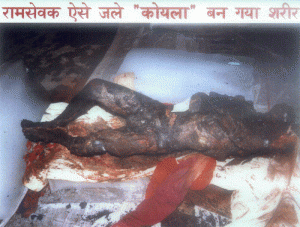


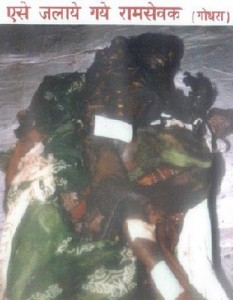
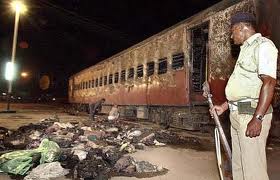
Anyone who understands human sufferings will realize the cause of the retaliation in Gujarat after looking at these pictures. However, some politicians and media people are blind to Hindu suffering. For some people, Hindus in general and VHP supporters in particular, are not even considered human beings. These gruesome killings also were not enough to soften the hardened hearts of the so-called secularists. One wonders then, what will ever make them condemn Muslims for any act, if they defend Muslims for Godhra and blame these children, who were roasted.

Leave A Comment